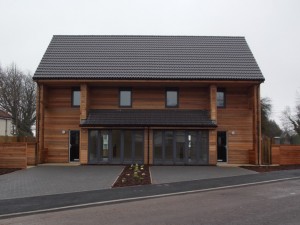West firms have worked together to design and build two zero-carbon homes in North Somerset that produce more energy than they use have been completed.
Halsall Construction, based in Bath, was selected for the design and build contract by housing association Alliance Homes through competitive tender and worked closely with Bristol architects Kendall Kingscott Partnership on the detailed design and Rise Structural Engineers, also based in Bristol, on structure and drainage.
The three-bedroom houses in Portishead, the first of their kind in the area, were commissioned as a practical trial of low and zero-carbon technologies and construction in everyday use by their service teams and residents.
The highly energy efficient homes have been built to level six of the Code for Sustainable Homes – the highest level possible. They have a combination of a well-insulated structure built from sustainable materials, triple glazed windows, photovoltaic panels that produce electricity and solar thermal heaters that produce hot water. The homes were built on a former garage site in which occupied an elevated south facing position optimising efficiency of the photovoltaic panels.
Halsall’s in-house licenced Code for Sustainable Homes assessor was able to have full involvement with both the design and construction teams ensuring that the ‘zero carbon’ strategy was implemented with design decisions being made early and collaboratively.
The cedar clad semi-detached homes feature large triple glazed windows creating well lit and pleasant living spaces, efficient internal water fittings and reducing water usage and bills, photovoltaic panels creating on-site energy generation for general household needs, and are fully Lifetime Homes compliant allowing for the changing needs of occupants.
Halsall design and sustainability manager and code assessor Nicola Thorogood said: “A key objective for the project was not to over complicate the design so that living in the home is easy and comfortable and maintenance for Alliance Homes is simple. Highly sustainable buildings are often very unusual in design, we are pleased that the simple practical design fits in with the local urban landscape and has made excellent use of an under used area.”






























